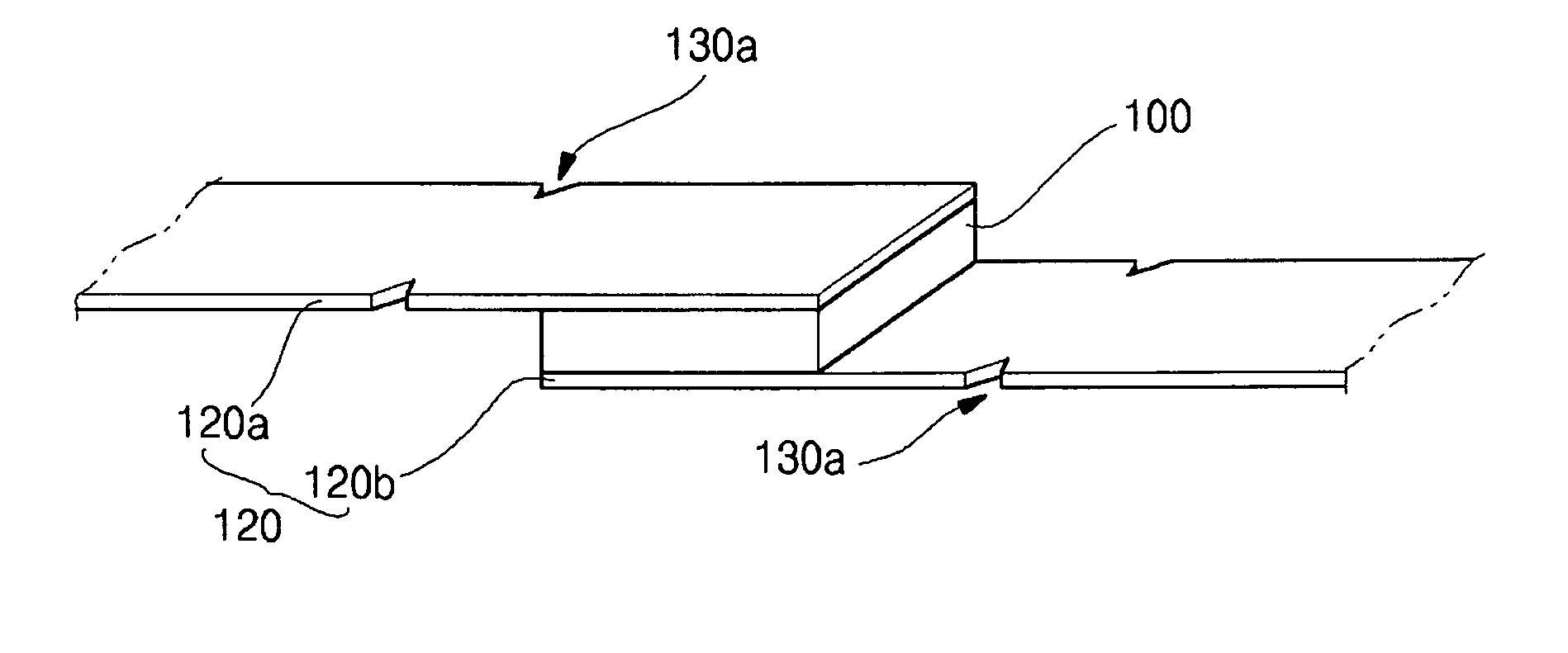Secondary protective element for secondary battery
a secondary battery and protective element technology, applied in the field of secondary protective elements for secondary batteries, can solve the problems of sudden rise in voltage, damage to functional elements, and difficulty in bending lead plates in a position away from functional elements by a predetermined distance, so as to prevent the characteristics of secondary protective elements from being degraded
- Summary
- Abstract
- Description
- Claims
- Application Information
AI Technical Summary
Benefits of technology
Problems solved by technology
Method used
Image
Examples
first embodiment
[0047] According to the present invention, as shown in FIG. 2, the lead plate 120 includes a bending section 130a formed at a predetermined portion of the lead plate 120 while being spaced from the functional element 100. The bending section 130a guides the bending position of the lead plate 120 in such a manner that the lead plate 120 can be bent about the bending section 130a. Preferably, the bending section 130a is spaced from the functional element 100 by at least 2 mm. If the distance between the bending section 130a and the function element 10 is shorter than 3 mm, the characteristics of the functional device 100 can be degraded while bending the lead plate 120.
[0048] The bending section 130 can be formed on at least one of the first lead plate 120a and the second lead plate 120b according to the shape of the secondary battery pack on which the secondary protective element is mounted. The bending section 130a can be formed with various shapes and sizes. Since the lead plate 12...
second embodiment
[0050] According to the present invention as shown in FIGS. 3a and 3b, a bending section 130b including an elongated aperture having a predetermined width and a predetermined length is formed in bending positions of the lead plate 120. The bending section 130b can be formed with various shapes, such as a square or oval shape, a rectangular shape, or a lozenge shape. The present invention does not limit the shape of the bending section 130b. In addition, since the bending section 130b guides the lead plate 120 such that a predetermined portion of the lead plate 120 can be bent, the bending section 130b is formed with a predetermined size sufficient for bending the lead plate 120. Preferably, a width of the bending section 130b is within 1.0 mm, and a length of the bending section 130b is within 50% of a width of the lead plate 120 so as to prevent the lead plate 120 from weakening, thereby preventing the lead plate 120 from being broken during bending or following processes.
third embodiment
[0051] According to the present invention, as shown in FIG. 4, bending sections 130c including at least two apertures are formed widthwise along the lead plate 120 while forming a predetermined interval therebetween. Preferably, a diameter or a width of the bending section 130c is within 1.0 mm so as to so as to prevent the lead plate 120 from weakening, thereby preventing the lead plate 120 from being broken during bending or following processes.
[0052] It is also possible to provide the bending section by combining the bending sections of FIGS. 2 and 3a or the bending sections of FIGS. 2 and 4.
PUM
| Property | Measurement | Unit |
|---|---|---|
| distance | aaaaa | aaaaa |
| length | aaaaa | aaaaa |
| thickness | aaaaa | aaaaa |
Abstract
Description
Claims
Application Information
 Login to View More
Login to View More - R&D
- Intellectual Property
- Life Sciences
- Materials
- Tech Scout
- Unparalleled Data Quality
- Higher Quality Content
- 60% Fewer Hallucinations
Browse by: Latest US Patents, China's latest patents, Technical Efficacy Thesaurus, Application Domain, Technology Topic, Popular Technical Reports.
© 2025 PatSnap. All rights reserved.Legal|Privacy policy|Modern Slavery Act Transparency Statement|Sitemap|About US| Contact US: help@patsnap.com



